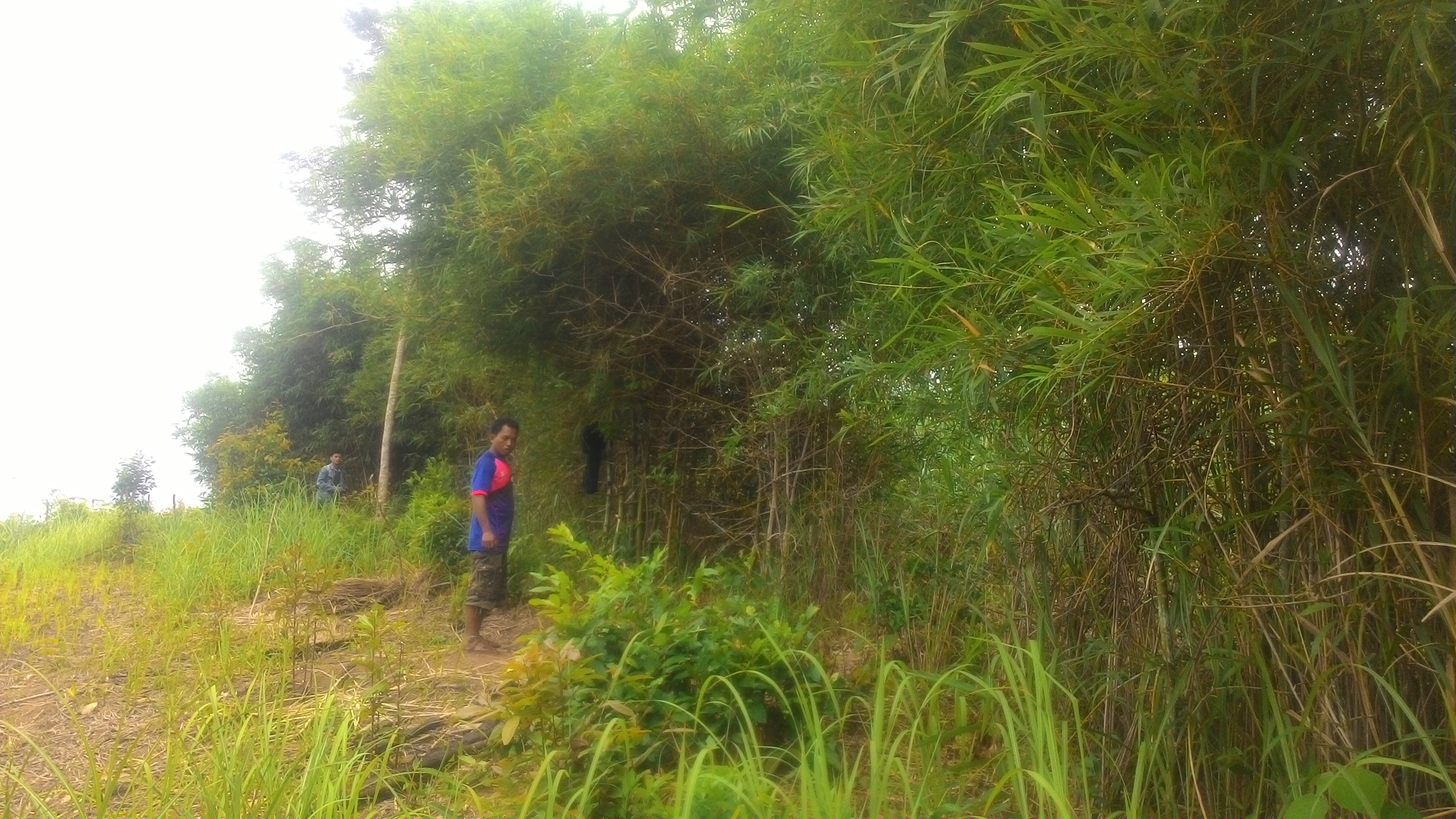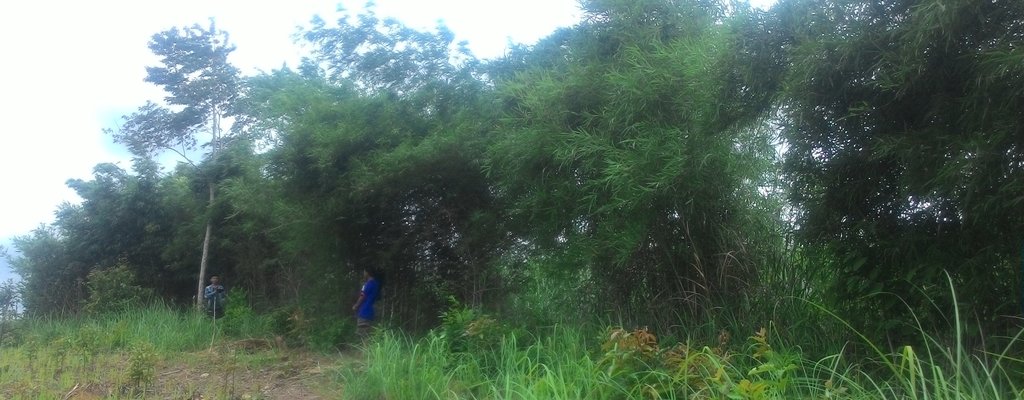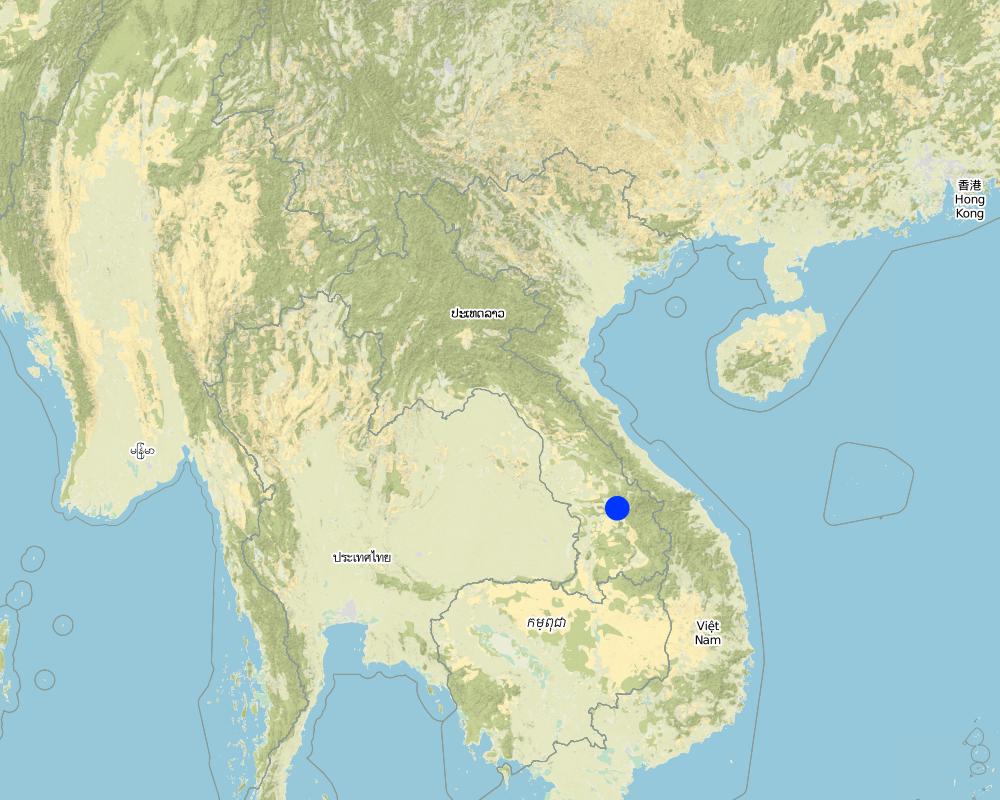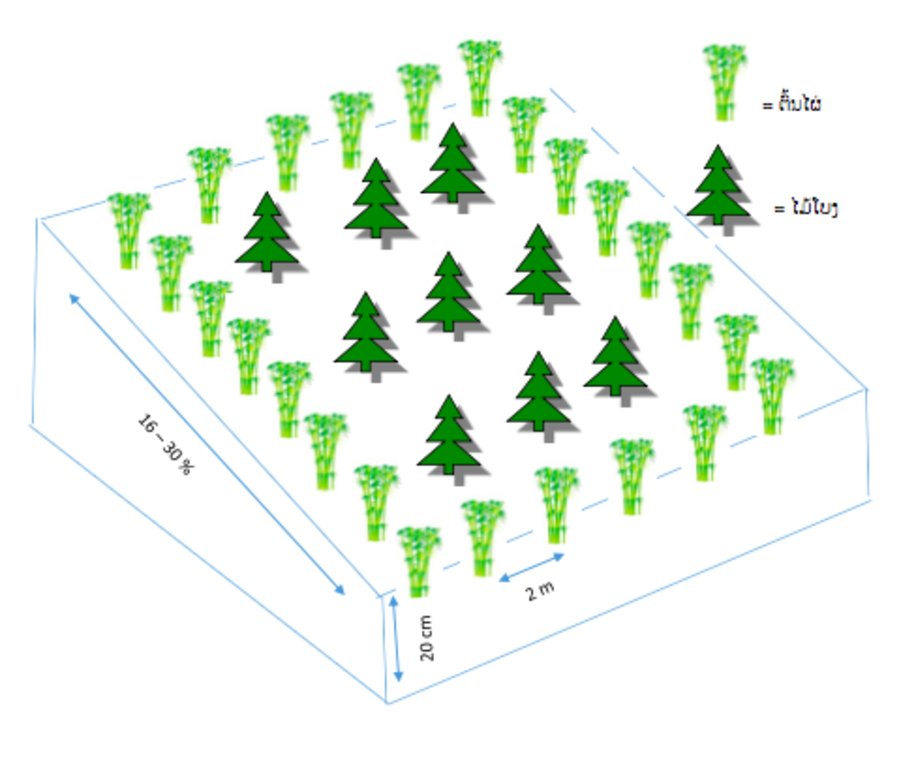Planting bamboo for fencing and wind protection [Lao People's Democratic Republic]
- Creation:
- Update:
- Compiler: jimmy luangphithack
- Editors: sackmysay SANIDBOUNMEE, Bounthanom Bouahom, Pasalath Khounsy, anousit namsena, kang phanvongsa
- Reviewers: Nicole Harari, viengsavanh phimphachanhvongsod, Alexandra Gavilano
technologies_2904 - Lao People's Democratic Republic
View sections
Expand all Collapse all1. General information
1.2 Contact details of resource persons and institutions involved in the assessment and documentation of the Technology
Key resource person(s)
land user:
Aphouy
Lao People's Democratic Republic
land user:
ທ່ານ ອາຢຸຍ
Lao People's Democratic Republic
Name of project which facilitated the documentation/ evaluation of the Technology (if relevant)
Scaling-up SLM practices by smallholder farmers (IFAD)Name of the institution(s) which facilitated the documentation/ evaluation of the Technology (if relevant)
National Agriculture and Forestry Research Institute (NAFRI) - Lao People's Democratic Republic1.3 Conditions regarding the use of data documented through WOCAT
The compiler and key resource person(s) accept the conditions regarding the use of data documented through WOCAT:
Yes
1.4 Declaration on sustainability of the described Technology
Is the Technology described here problematic with regard to land degradation, so that it cannot be declared a sustainable land management technology?
No
2. Description of the SLM Technology
2.1 Short description of the Technology
Definition of the Technology:
Bamboo is planted for fencing agricultural land, protecting the land from strong winds and reducing the demand of wood from the forest. Bamboo shoots are also a source of nourishment and income generation.
2.2 Detailed description of the Technology
Description:
After experiencing serious impacts from the typhoon Ketsana in 2010, which included the loss of agricultural produce, the farmers needed to examine means of protecting their Yang Bong tree plantation from strong wind. One of the methods is to plant bamboo to act as fencing which at the same time protects the crops from strong winds. Initially farmers observed that natural bamboo grows in plentiful supplies along the stream banks and islands within the watercourses. Therefore, this stimulated their interest and so to start off with they conducted a trial with two tuffs. They noticed that the bamboo grows quite quickly and that the stems are a reasonably good protection against strong winds. The farmers thus decided to extend the area under cultivation and plant it around the edge of their Yang Bong tree plantation, which is approximately 1 hectare. In fact, farmers had usually harvested considerable amounts of bamboo from the surrounding natural forests for the construction of fencing around their agriculture land. This practice had actually placed ever increasing pressure on these natural forests, is quite time consuming and requires considerable labour power in order to transport it over long distances.
Normally, bamboo fences need to be constructed and maintained annually in the first year of bamboo plantation. Moreover, there is also the issue of wildlife and livestock damaging the plantation area, which results in the loss of produce (approximately 70- 80% of the damaged area).
The bamboo should be planted in holes with a diameter and a depth of 20 cm with a gap of 2 m between each hole. The seedlings are selected from one to two year old stems. The individual rhizomes should be removed from parent plant and then the roots trimmed. The bamboo culms should not be too long, normally about 50-80 cm, about the length of an average human arm. Replanting should take place on the same day and at the very latest not more than two days after the rhizomes have been collected from the parent plant. May and June are the most appropriate months for planting as this is the start of the wet season. Bamboo should flourish during this period and thus it reduces the likelihood that the bamboo seedlings will wither. Maintenance of the plants may require watering, especially during the dry season, which should be done once every five to seven days until the commencement of the rainy season. Watering may not be necessary once the bamboo plants have been able to survive for two years, but they should be weeded at least twice per year.
Planting bamboo provides environmental, economic and social benefits. It helps to increase soil nutrients, porosity, and moisture and lower the temperature of the immediate surroundings. Bamboo shoots are a source of food and bamboo culms can be used for many purposes, such as the manufacture of handicrafts. Dried out bamboo can be sold for 40.000 Kip/kg and, on average, each farmer is able to sell up to 40kg per year. It is possible to harvest bamboo shoots three years after the rhizomes have been planted. Households have learnt from these positive experiences and began to plant bamboo around their rice paddies and home gardens to prevent livestock from damaging their crops and gain additional benefits.
2.3 Photos of the Technology
2.5 Country/ region/ locations where the Technology has been applied and which are covered by this assessment
Country:
Lao People's Democratic Republic
Region/ State/ Province:
Salavan province
Further specification of location:
Samouy
Specify the spread of the Technology:
- evenly spread over an area
If precise area is not known, indicate approximate area covered:
- 0.1-1 km2
Map
×2.6 Date of implementation
Indicate year of implementation:
2009
If precise year is not known, indicate approximate date:
- less than 10 years ago (recently)
2.7 Introduction of the Technology
Specify how the Technology was introduced:
- through land users' innovation
3. Classification of the SLM Technology
3.1 Main purpose(s) of the Technology
- reduce, prevent, restore land degradation
- reduce risk of disasters
- adapt to climate change/ extremes and its impacts
- create beneficial economic impact
- create beneficial social impact
3.2 Current land use type(s) where the Technology is applied

Cropland
- Tree and shrub cropping
- Yangbong tree (Nothaphoebe umbelliflora)
Number of growing seasons per year:
- 1

Forest/ woodlands
- Tree plantation, afforestation
Type of tree:
- Bamboo bamboo
Products and services:
- Nature conservation/ protection
- Protection against natural hazards
Comments:
Main crops (cash and food crops): Yangbong tree plantation
3.4 Water supply
Water supply for the land on which the Technology is applied:
- rainfed
3.5 SLM group to which the Technology belongs
- windbreak/ shelterbelt
- integrated soil fertility management
3.6 SLM measures comprising the Technology

vegetative measures
- V1: Tree and shrub cover

structural measures
- S6: Walls, barriers, palisades, fences
3.7 Main types of land degradation addressed by the Technology

soil erosion by wind
- Eo: offsite degradation effects
3.8 Prevention, reduction, or restoration of land degradation
Specify the goal of the Technology with regard to land degradation:
- adapt to land degradation
4. Technical specifications, implementation activities, inputs, and costs
4.1 Technical drawing of the Technology
Technical specifications (related to technical drawing):
The land users plant bamboo around the agricultural land, where bong trees (nothaphoebe umbelliflora) are planted . Healthy bamboo plants can be collected from strong roots, branches or remaining culms. They have to be about 40- 60 cm long (approximately 8 bags of bamboo seedlings).
After collection, the required rhizomes can be replanted immediately (or within 7 days after collection). Appropriate planting space is 2m x 2m.
The size of the planting pit is about 40 cm x 40 cm. The planting should be taken place in the early rainy season to reduce the requirement for watering and the risk of the seedling to die after planting. Once planting is completed, it may need weeding twice a year.
Author:
Jimmy Luanglath
Date:
05/07/2017
4.2 General information regarding the calculation of inputs and costs
Specify how costs and inputs were calculated:
- per Technology area
Indicate size and area unit:
1 Hactare
other/ national currency (specify):
LAK
If relevant, indicate exchange rate from USD to local currency (e.g. 1 USD = 79.9 Brazilian Real): 1 USD =:
8000.0
Indicate average wage cost of hired labour per day:
30000
4.3 Establishment activities
| Activity | Timing (season) | |
|---|---|---|
| 1. | Landpreparation | DryseasononJanuarytoFebuary) |
| 2. | Slash and burn | March |
| 3. | Collect the bamboo seedlings | 1 week after finish land preparation |
| 4. | Planting bamboo | rainy season |
| 5. | Weeding along bamboo fencing | 3times per year |
4.4 Costs and inputs needed for establishment
| Specify input | Unit | Quantity | Costs per Unit | Total costs per input | % of costs borne by land users | |
|---|---|---|---|---|---|---|
| Equipment | Knife for weeding | piece | 4.0 | 30000.0 | 120000.0 | 100.0 |
| Equipment | Big knife to cut the bamboo tree | piece | 1.0 | 100000.0 | 100000.0 | 100.0 |
| Total costs for establishment of the Technology | 220000.0 | |||||
| Total costs for establishment of the Technology in USD | 27.5 | |||||
4.5 Maintenance/ recurrent activities
| Activity | Timing/ frequency | |
|---|---|---|
| 1. | Weeding along bamboo fencing | During the first year of plantation(3timesperyear |
4.6 Costs and inputs needed for maintenance/ recurrent activities (per year)
| Specify input | Unit | Quantity | Costs per Unit | Total costs per input | % of costs borne by land users | |
|---|---|---|---|---|---|---|
| Labour | Labour for weeding | person day | 6.0 | 30000.0 | 180000.0 | 100.0 |
| Total costs for maintenance of the Technology | 180000.0 | |||||
| Total costs for maintenance of the Technology in USD | 22.5 | |||||
4.7 Most important factors affecting the costs
Describe the most determinate factors affecting the costs:
Bamboo seedlings are an important factor affecting the costs. Family members go to collect the bamboo seedlings from the forest.
5. Natural and human environment
5.1 Climate
Annual rainfall
- < 250 mm
- 251-500 mm
- 501-750 mm
- 751-1,000 mm
- 1,001-1,500 mm
- 1,501-2,000 mm
- 2,001-3,000 mm
- 3,001-4,000 mm
- > 4,000 mm
Indicate the name of the reference meteorological station considered:
Samouy meteorological station
Agro-climatic zone
- humid
5.2 Topography
Slopes on average:
- flat (0-2%)
- gentle (3-5%)
- moderate (6-10%)
- rolling (11-15%)
- hilly (16-30%)
- steep (31-60%)
- very steep (>60%)
Landforms:
- plateau/plains
- ridges
- mountain slopes
- hill slopes
- footslopes
- valley floors
Altitudinal zone:
- 0-100 m a.s.l.
- 101-500 m a.s.l.
- 501-1,000 m a.s.l.
- 1,001-1,500 m a.s.l.
- 1,501-2,000 m a.s.l.
- 2,001-2,500 m a.s.l.
- 2,501-3,000 m a.s.l.
- 3,001-4,000 m a.s.l.
- > 4,000 m a.s.l.
Indicate if the Technology is specifically applied in:
- not relevant
5.3 Soils
Soil depth on average:
- very shallow (0-20 cm)
- shallow (21-50 cm)
- moderately deep (51-80 cm)
- deep (81-120 cm)
- very deep (> 120 cm)
Soil texture (topsoil):
- medium (loamy, silty)
Soil texture (> 20 cm below surface):
- medium (loamy, silty)
Topsoil organic matter:
- medium (1-3%)
5.4 Water availability and quality
Ground water table:
5-50 m
Availability of surface water:
poor/ none
Water quality (untreated):
good drinking water
Is water salinity a problem?
No
Is flooding of the area occurring?
No
5.5 Biodiversity
Species diversity:
- medium
Habitat diversity:
- medium
5.6 Characteristics of land users applying the Technology
Sedentary or nomadic:
- Sedentary
Market orientation of production system:
- mixed (subsistence/ commercial)
Off-farm income:
- 10-50% of all income
Relative level of wealth:
- average
Individuals or groups:
- individual/ household
Level of mechanization:
- manual work
Gender:
- women
- men
Age of land users:
- middle-aged
5.7 Average area of land used by land users applying the Technology
- < 0.5 ha
- 0.5-1 ha
- 1-2 ha
- 2-5 ha
- 5-15 ha
- 15-50 ha
- 50-100 ha
- 100-500 ha
- 500-1,000 ha
- 1,000-10,000 ha
- > 10,000 ha
Is this considered small-, medium- or large-scale (referring to local context)?
- small-scale
5.8 Land ownership, land use rights, and water use rights
Land ownership:
- individual, titled
Land use rights:
- individual
Water use rights:
- open access (unorganized)
5.9 Access to services and infrastructure
health:
- poor
- moderate
- good
education:
- poor
- moderate
- good
technical assistance:
- poor
- moderate
- good
employment (e.g. off-farm):
- poor
- moderate
- good
markets:
- poor
- moderate
- good
energy:
- poor
- moderate
- good
roads and transport:
- poor
- moderate
- good
drinking water and sanitation:
- poor
- moderate
- good
financial services:
- poor
- moderate
- good
6. Impacts and concluding statements
6.1 On-site impacts the Technology has shown
Socio-economic impacts
Income and costs
farm income
Comments/ specify:
The land user can earn income from bamboo shoots (1,600,000 LAK/year)
diversity of income sources
Comments/ specify:
Increased income from bamboo shoots and Yang Bong trees.
workload
Comments/ specify:
Land user's workload to go to collect and cut the wood from the forest to make fencing is reduced.
Ecological impacts
Soil
soil moisture
Comments/ specify:
Increase soil nutrients, porosity, and moisture.
Climate and disaster risk reduction
impacts of cyclones, rain storms
Comments/ specify:
Bamboo trees getting bigger and taller can prevent the strong winds.
wind velocity
Comments/ specify:
Decreased wind velocity protecting Yang Bong trees plantation area.
6.2 Off-site impacts the Technology has shown
wood logging from forest
Comments/ specify:
Reduced the wood logging from forest to make fences.
6.4 Cost-benefit analysis
How do the benefits compare with the establishment costs (from land users’ perspective)?
Short-term returns:
slightly positive
Long-term returns:
very positive
How do the benefits compare with the maintenance/ recurrent costs (from land users' perspective)?
Short-term returns:
positive
Long-term returns:
positive
6.5 Adoption of the Technology
- 1-10%
If available, quantify (no. of households and/ or area covered):
2 households
Of all those who have adopted the Technology, how many did so spontaneously, i.e. without receiving any material incentives/ payments?
- 11-50%
6.6 Adaptation
Has the Technology been modified recently to adapt to changing conditions?
Yes
other (specify):
Different way of bamboo planting
6.7 Strengths/ advantages/ opportunities of the Technology
| Strengths/ advantages/ opportunities in the land user’s view |
|---|
| One of the methods is to plant bamboo to act as fencing which at the same time protects the Yang Bong trees from strong winds. |
| Prevents livestock and wildlife from damaging Yang Bong trees as bamboo produces many culms that impede animals from entering agricultural areas. |
| Bamboo can be used for handicraft activities (bamboo wall, bamboo sheets). Bamboo shoots are a source of food and can be sold to generate household income. |
| Strengths/ advantages/ opportunities in the compiler’s or other key resource person’s view |
|---|
| The bamboo can also withstand against wind to some extent. The bamboo roots penetrate deep into the soil and are thus preventing soil erosion. The bamboo also acts to some extent as a wind barrier. |
| The land user can save time and labour for harvesting bamboo shoots for household consumption. |
| Reduce the wood logging from forest to make fences. |
6.8 Weaknesses/ disadvantages/ risks of the Technology and ways of overcoming them
| Weaknesses/ disadvantages/ risks in the land user’s view | How can they be overcome? |
|---|---|
| Crops that are shaded by bamboo will not flourish as successfully or will produce low yields. Therefore, bamboo branches need to be trimmed regularly. | Therefore, it requires regular trimming of branches. |
| Some people in the village steal bamboo shoots without getting permission. |
7. References and links
7.1 Methods/ sources of information
- field visits, field surveys
1
- interviews with land users
1
When were the data compiled (in the field)?
04/07/2017
Links and modules
Expand all Collapse allLinks
No links
Modules
No modules







